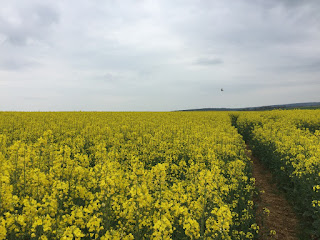After a hectic March due to an unexpected, unplanned trip to India, we needed a place to get away, to slow down and rejuvenate. A cross-channel road trip through the famous Burgundy region sounded like just that kind of trip.
An hour and half drive from our house took us to the Eurotunnel terminal at Folkestone and before we knew it, I was driving our car into a train that was going to take us under the English Channel, through a 38 km long undersea tunnel! The 35 minute trip in one of human kind's crowning glories of engineering achievements went by quick and we emerged onto a sunny Spring afternoon at the Calais terminal in France.
Driving out of the terminal, we got onto the busy A1 motorway and started the 503 km journey though the heartland of France. The steady traffic of loaded lorries and fast cars with license plates from countries all over Europe had us frustrated as we were falling behind schedule. Getting off the A1 and on to the A6 - Autoroute du Soleil (Motorway of the Sun) however, the landscape changed to rolling hills with large fields in varying shades of green alternating with blazing yellow rapeseed fields. On the horizon, white windmills stood guard while grey and white clouds played tag with the sun. Our bucolic road trip had begun!

As we made our way through the hills and vales of France crisscrossed with small rivers and streams every few miles, the landscape was agricultural, but no vineyards were in view. We were headed to the famed Cote d’Or, home of the haughty Burgundy wines but there was not a grapevine in sight. What we did see were herds of white Charolais cows, dirty sheep and handsome horses grazing to their hearts’ content. Soon, we were driving through tiny medieval villages with ancient stone houses, leafy squares around the village church with its characteristic slate steeples and musical names like Sauvigny, Joux de Ville and Lucy le-Bois eventually to Avallon and our destination - a farmhouse converted to a charming bed and breakfast. We had been on the road for more than 9 hours and it was time for dinner and an early night.
With no sight-seeing stops on the agenda, this trip was about driving through the hills and vales of the French countryside, stopping on the side of the road to ‘frolic in the fields’ as the kids called it and tasting the famed Burgundy wines in tiny family-owned Domaines. We met some of the friendliest people anywhere in Europe as we drove on the Route des Grand Crus passing villages with names seen on wine-bottle labels around the world - Chablis, Vosnee-Romanee, Aloxe-Corton, Nuits Saint George, Gevrey-Chembertin. We explored vineyards with inviting signs for degustations. We listened as a passionate vigneron explained the essence of Burgundy wines. How unlike Bordeaux wines which depend on the skill of the winemaker, the wines here are entirely a reflection of the terroir where the grape comes from - the composition of the soil, the water and the air where the plant grows. We learnt how the location of the vine - whether at the crest of a hill, along the sloping sides or in the shade of a rocky hilltop makes the difference between a cheap-ish, everyday-at-6pm Village, medium priced yet lofty Premier Cru or the high and mighty, only-open-it-for-anniversary or to impress your neighbor Grand Cru.
We walked through ancient towns of Vezelay, Comarrin, Flavigny-sur-Ozerain, admiring the pointed slate steeples of churches that looked like the tops of medieval helmets, drove along the river Yonne and Burgundy canal that nourish this verdant valley, explored the hilltop castle of the Duke of Burgundy at Chateauneuf-en-Auxois and walked along the ruins of Alise-Saint-Reine where Vercingetorix, the last king of Gauls, fought an epic battle again Julius Caesar.


There was time for some ‘sight-seeing’ in the charming town of Beaune, in the form of the Hospices du Beaune. Founded in 1443 by Nicolas Rolin as a charitable hospital for the poor, it is now a museum and an excellent showcase of 15th century French architecture. The glazed tile roofs of red, brown, green and yellow tiles laced together in intricate patterns is a trademark of Burgundy architecture. A visit to a local antiques fair and shopping ended another gorgeous day in Bourgogne.
So, let us talk about the food, shall we? Obviously I am not the first person to rave about French food, but eaten here on the land where it grows, without the pretense of a Paris bistro or cafe, your tastebuds take your soul to a sublime place where the nothing can go wrong. Whether it was home-made, creamy foie gras, or fresh salad dressed with a drizzle of truffle oil or perfectly cooked duck confit or fall-of the bone beef bourgogone, Jambon perseille, Oeuf en gelee, Oeuf en meurette - perfectly poached eggs in a silky red wine sauce or the cheeses - firm and creamy Comte, the sharp Tonnerre or the prickly Epoisses….this list is a long one. The chefs here are quite comfortable with their cooking skills to experiment with unusual ingredients in traditional dishes like a dash of ginger syrup in a light vinaigrette or curry powder on perfectly cooked Potato Parmentiers. But there is such a thing as too much of a good thing, I suppose and we found ourselves seeking out the familiar banality of McDonald’s, KFC(Kentucky French Chicken) and Subway for lunch a few times, although we stayed true to the mood of our trip by washing them down with the local Vueve Ambal!
We said au revoir to the peaceful Bourgogne region with a renewed appreciation of the rural life, a life led close to the land and in harmony with nature. And wishing we had more time to indulge in this pastoral, peaceful way of life, we powered up the GPS and plotted our route to the predictable chaos of real life.






































